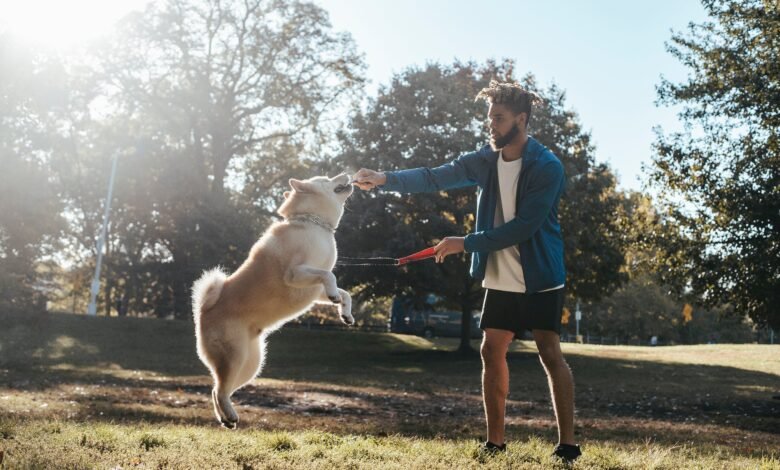Teaching Tricks: Fun and Engaging Ways to Stimulate Your Dog’s Mind

Our furry companions are not just pets; they are intelligent beings with a capacity for learning and joy. Teaching tricks is an excellent way to tap into your dog’s cognitive abilities, providing mental stimulation and strengthening the bond between you two. In this guide, we’ll explore fun and engaging ways to stimulate your dog’s mind through the art of teaching tricks.
Understanding the Benefits of Trick Training
Mental Stimulation
Dogs, like humans, thrive on mental challenges. Trick training engages their minds, preventing boredom and promoting a healthy, active brain. A mentally stimulated dog is often a happier and more well-behaved companion.
Bond Strengthening
The shared experience of learning tricks fosters a stronger bond between you and your dog. It builds trust, communication, and a sense of accomplishment, creating a positive and rewarding dynamic in your relationship.
Getting Started with Trick Training
Patience and Positive Reinforcement
Before diving into specific tricks, understand that patience is your best ally. Dogs respond positively to patience and encouragement. Use treats, praise, and even playtime as rewards to reinforce positive behavior during training sessions.
Clear Communication
Dogs rely on cues and signals. Ensure your commands are clear and consistent. Use a cheerful tone and maintain an encouraging demeanor to make the learning process enjoyable for your dog.
Trick Ideas for Beginners
1. Sit Pretty
Teaching your dog to sit pretty involves them sitting back on their haunches, front paws in the air. Start by holding a treat above their head, encouraging them to lift their front paws. Reward them when they maintain the position. This trick enhances your dog’s balance and is an adorable crowd-pleaser.
2. High-Five
High-fiving is a simple yet delightful trick. Begin by commanding your dog to sit, then offer your hand. When they touch their paw to your hand, reward them. Repetition and positive reinforcement turn this into a charming gesture that showcases your dog’s intelligence.
3. Roll Over
Rolling over is a classic trick that combines entertainment with physical activity. Start with your dog in a “down” position, then guide them gently to the side while using a treat. As they roll over, reward them with praise and treats. This trick not only stimulates your dog’s mind but also encourages flexibility and coordination.
4. Spin Around
Spinning around is a dynamic trick that adds flair to your dog’s repertoire. With a treat in hand, guide your dog in a circular motion. As they follow the treat, say the command “spin” and reward them when they complete the rotation. This trick not only entertains but also enhances your dog’s spatial awareness.
5. Fetch and Retrieve
While fetching might seem like a basic game, teaching your dog to fetch and retrieve specific items takes it to the next level. Start with a favorite toy, throw it a short distance, and encourage your dog to bring it back. Gradually increase the distance and introduce different objects. This trick engages their problem-solving skills and provides both mental and physical exercise.
Intermediate Tricks for More Challenge
6. Paw Targeting
Paw targeting involves teaching your dog to touch a specific object with their paw. Begin by presenting an object (like a small mat) and rewarding your dog when they touch it with their paw. Gradually increase the distance between your hand and the object. This trick enhances their coordination and focus.
7. Speak on Command
Teaching your dog to speak on command is not only entertaining but also a practical skill. Start by encouraging natural barking, then introduce the command “speak.” Reward them when they vocalize on cue. This trick allows you to control their barking and adds an interactive element to your communication.
Advanced Tricks for Brain Challenge
8. Shell Game
The shell game is an advanced trick that tests your dog’s memory and problem-solving abilities. Place a treat under one of three cups, shuffle them, and encourage your dog to find the treat. Reward them when they choose the correct cup. This challenging game stimulates their cognitive skills and provides a rewarding mental workout.
9. Ring the Bell
Teaching your dog to ring a bell is both practical and adorable. Hang a bell near the door and encourage your dog to touch it with their nose or paw before going outside. Consistent positive reinforcement associates the bell with the action, creating an effective communication tool for your dog.
10. Play Dead
Adding a theatrical touch to your dog’s repertoire, the “play dead” trick involves them lying on their side as if they’ve succumbed to a dramatic demise. Start with the “down” command, then gently guide them onto their side. Reward them for holding the position. This trick showcases your dog’s ability to follow complex cues.
Tips for Successful Trick Training
Consistency is Key
Consistency is the backbone of successful trick training. Use the same commands, reward system, and gestures consistently to avoid confusion. Dogs thrive on routine, and a consistent approach accelerates the learning process.
Keep Sessions Short and Fun
Dogs, like humans, have limited attention spans. Keep training sessions short, around 5-10 minutes, and infused with fun. End on a positive note with a successful trick or a favorite treat, leaving your dog excited for the next training session.
Use High-Value Rewards
While verbal praise is essential, using high-value treats as rewards can significantly motivate your dog. Reserve special treats exclusively for training sessions to create a strong association between the trick and the reward.
Conclusion
Teaching tricks to your dog is a joyful journey that goes beyond mere entertainment. It forges a stronger bond, stimulates their mind, and enhances your communication. As you embark on this adventure, revel in the joy of each successfully learned trick, and celebrate the unique talents of your furry friend.
Frequently Asked Questions (FAQs)
- How long does it take to teach a dog a new trick?
- The time varies based on the complexity of the trick and your dog’s learning pace. Some tricks may take a few sessions, while others may require more patience and practice.
- Can older dogs learn new tricks?
- Absolutely! Dogs of all ages can learn new tricks with patience, positive reinforcement, and consistent training.
- What if my dog seems uninterested in trick training?
- Assess the environment and ensure it’s conducive to learning. Use higher-value rewards, change up the training location, and make the sessions more engaging to reignite their interest.
- Are certain breeds more inclined to learn tricks?
- While individual temperament varies, most dogs, regardless of breed, can learn tricks. Tailor your approach to your dog’s personality, and you’ll be surprised at their capabilities.
- How often should I practice trick training with my dog?
- Aim for a few short sessions per week to keep your dog engaged and prevent boredom. Adjust the frequency based on your dog’s enthusiasm and energy levels.
Embark on the journey of trick training with your furry friend, and you’ll discover the joy of unlocking their hidden talents while strengthening the incredible bond you share.




